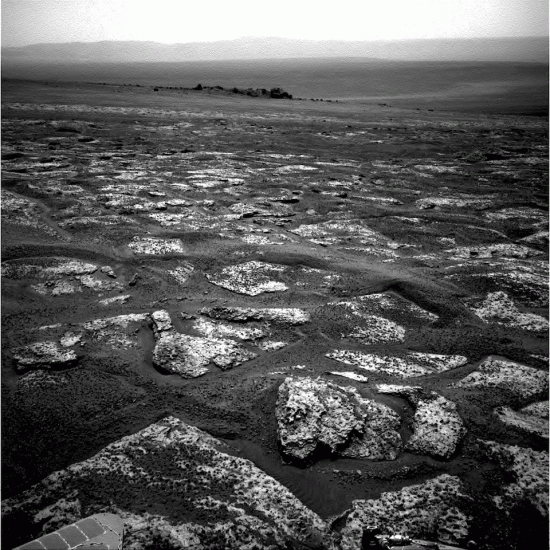May 14, 2012
After a long winter, the Mars Exploration Rover B is starting to roll through the Martian terrain.
The Mars Exploration Rover (MER) Opportunity has been traveling across the face of the Red Planet since Sunday, January 5, 2004. Opportunity was launched on July 7, 2003, and after a six month journey, it bounced to a landing inside a newly developed airbag system that cushioned its impact with the surface of Meridiani Planum. Opportunity was meant for no more than a six month sojourn in the frozen desert of Mars, but the data it gathered compelled NASA managers to continue its mission indefinitely.
Opportunity was preceded by its twin rover, Spirit. However, in June of 2009, Spirit became stuck in a sand trap and was unable to maneuver into a position where its solar cells could keep its batteries charged. After it lost power in the deep cold of the 2009 Martian winter, the rover ceased communications on March 24, 2010. On May 25, 2011 NASA announced that it would no longer send signals to Spirit, signifying the end of the “Spirit recovery project”. Opportunity, on the other hand, remains healthy and able to travel.
During its many years of travel, Opportunity has provided a wealth of information about the topography of Mars, as well as an analysis of its chemical composition. The surface of Mars appears to be rich in silicon dioxide, otherwise known as quartz, and in various iron oxides, especially hematite and magnetite.
Among Opportunity’s most significant findings are the vast collections of so-called “blueberries” that have accumulated in their trillions on the surface. Note that the term “blueberry” is not because of their color but because the mission team was stunned by their presence within the matrices of several large rocks. They are so abundant that Steve Squyres referred to them as “blueberries in a muffin.”
One of the most dramatic aspects of the blueberry discovery is their close resemblance to stone spherules on Earth called “Moqui marbles.” Moqui marbles can be found in many areas of the Southwestern United States. They are highly unusual because of their interior construction: the majority of them are iron shells enclosing a sandstone core. They are also found embedded in the walls of some canyons and within large boulders. Some of the Moqui marbles are hollow, and some of them are surrounded by an equatorial ridge; looking like miniature versions of Saturn’s moon Iapetus.
On Mars, the blueberries come in various sizes, with the smallest gathered into drift-like dunes that literally stretch from horizon to horizon. Some of the largest lie within cracks inside shattered polygonal paving stones. The hematite blueberries are often associated with the expanses of shattered quartz, although the reason remains obscure to planetary scientists.
As mentioned, Mars is largely composed of iron and silicon, with massive quantities of oxygen bound into the soils and bedrock. The atmosphere on Mars is of such low density it is sometimes described as standing on top of a mountain six-times higher than Everest, so it lacks the ability to aggressively attack the Martian lithosphere.
On Earth, water vapor in the atmosphere forms a weak carbonic acid solution when it mixes with carbon dioxide, so that helps to wear away the rocks. On Mars, such erosion is impossible for several obvious reasons, not the least of which is that there is no open water on Mars or in its atmosphere.
The presence of iron oxide in several different forms indicates that something not taking place on any large scale today did take place at some time in the past. When that past imposed its influence on Mars depends on which of many suppositions are considered. Most Mars research groups speculate that there was once a dense, oxygen-rich atmosphere that allowed for the “rusting” of iron in its crust to take place.
Others suggest that there were oceans of open water on the surface that helped to form the hematite nodules covering nearly a whole hemisphere (perhaps more). Whatever the source, Mars has hematite dunes a kilometer high, giant cracks that go on for hundreds of kilometers with their bottoms covered in hematite ripples, and seas of hematite dust tens of meters deep swallowing craters a hundred kilometers in diameter.
Elemental transmutation through the z-pinch effect is not considered in conventional theories, so there are few avenues of experimentation left open. Precipitation and chemical recombination appear to be the main arguments put forward by Mars research scientists, so their theories about its evolution are often inconsistent. Relying upon hypotheses that ignore electromagnetic forces will always produce erroneous conclusions.
It is unusual that dark hematite is so intimately bound up with white silicon-dioxide rock. Could there be a connection between silica and hematite on Mars? Could the same electric arcs that are thought to have carved the Red Planet transmute elements: reforming the atomic structure of silicon (with 28 particles in its nucleus) into that of iron (with 56)? Perhaps that connection could also explain the Moqui marbles with their iron oxide and silicon dioxide composition?
Stephen Smith
Now Available – Seeking the Third Story DVD

2 Lectures by David Talbott
According to author David Talbott, all of human history can be seen as just two stories.
First, came the story of ancient mythology, when towering gods were said to have ruled the world. Then came the story of science, emerging from a growing distrust of the myths and a new emphasis on direct observation and reason.
But a third story is possible, according to Talbott, one that sees the underlying provocation of the myths in extraordinary electrical events occurring close to the Earth. To be believed, a third story must be more coherent and more meaningful than either archaic religious mythologies or the modern mythologies of popular science.













